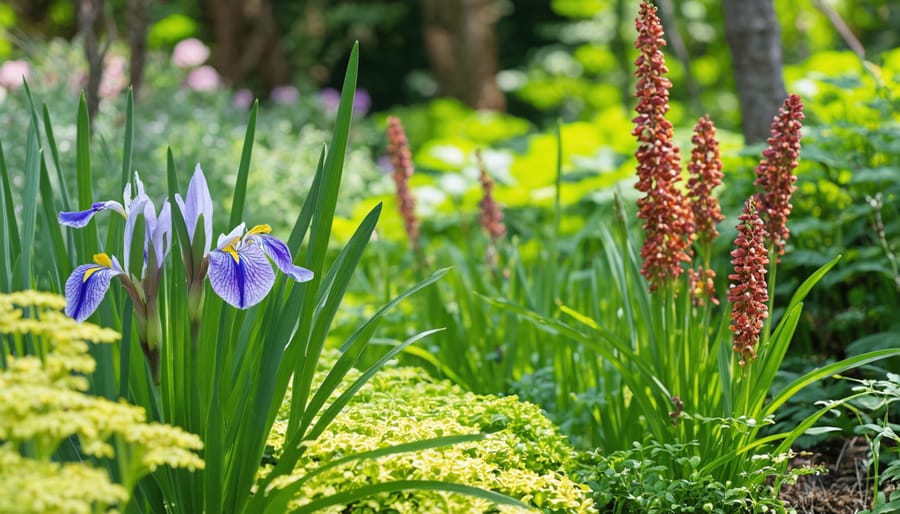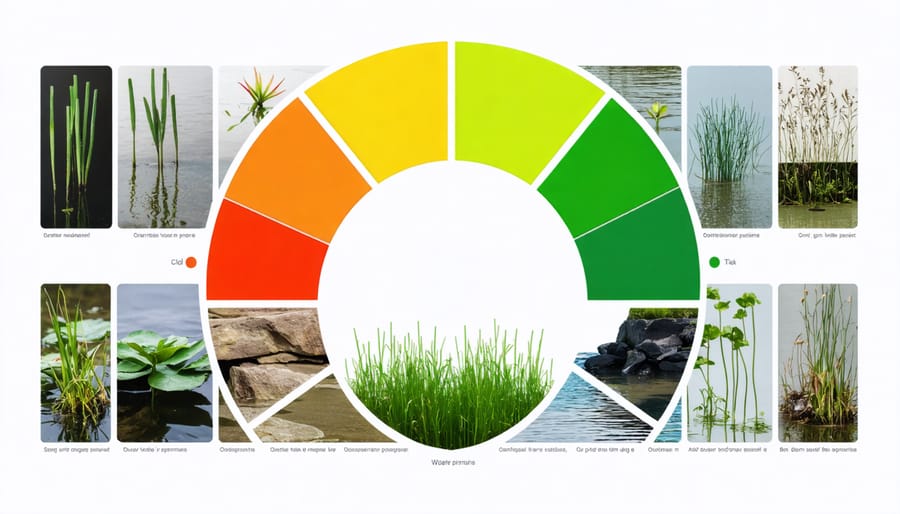
Create a Stunning Water Garden with These Perfect Multicolor Plant Combinations
Transform your outdoor space into a living canvas with multicolor plants – nature’s answer to adding instant vibrancy and year-round interest to any garden. From the striking purple-and-silver leaves of Persian Shield to the rainbow-hued foliage of Coleus varieties, these botanical wonders offer an exciting alternative to traditional green plantings. Whether you’re designing a shade garden that glows with Japanese Painted Ferns or creating sun-drenched borders with variegated Coral Bells, multicolor plants provide endless possibilities for creative expression. Modern breeding has produced an impressive array of plants featuring splashed, striped, and mottled patterns that change throughout the seasons, ensuring your garden remains dynamic and engaging. Perfect for both novice gardeners and experienced landscapers, these versatile plants can create stunning focal points, tie together different garden areas, or add that perfect pop of color to container arrangements. Let’s explore how to select, combine, and care for these spectacular specimens to create your own kaleidoscope of natural color.
Why Multicolor Plants Transform Water Gardens
Visual Impact Through the Seasons
Multicolor plants are the ultimate garden performers, putting on a spectacular show throughout the year. In spring, watch as fresh variegated leaves emerge, often tinged with pink or red hues. Summer brings the boldest display, with mature foliage showing its full range of colors and patterns. Fall transforms many varieties with unexpected color shifts – green and white leaves might develop bronze or purple tones. Even in winter, evergreen varieties like Japanese Maples maintain their striking patterns, while deciduous plants reveal interesting bark textures and stems. By carefully selecting plants with different peak seasons, you can create a garden that never loses its visual appeal. Consider combining early-season performers with late-blooming varieties to ensure continuous color from frost to frost.

Creating Depth and Dimension
Creating depth in your water garden is like painting a masterpiece with living colors. By strategically placing plants of different heights and hues, you can develop stunning visual layers that draw the eye through your aquatic landscape. Start with tall, dramatic plants like purple-tinged papyrus in the background, then work your way forward with medium-height varieties like colorful lotus or variegated iris. In the foreground, incorporate floating plants with contrasting colors, such as red-tinged water lilies alongside bright green water lettuce. This layered approach not only adds visual interest but also creates natural transitions between different areas of your water garden. Remember to consider seasonal color changes when planning your design, ensuring year-round visual appeal through carefully selected plant combinations.
Top Multicolor Plant Selections for Water Gardens
Marginal Plants
The edge of your pond offers exciting opportunities to create stunning color displays with marginal plants. These beauties thrive in shallow water or moist soil around your pond’s perimeter, adding vibrant splashes of color at different heights. Consider the striking purple-and-white blooms of iris louisiana, which create a dramatic contrast against their sword-like green foliage. For a warm color palette, try the yellow flag iris or the orange-flowering pickerelweed, both offering months of cheerful blooms.
Don’t overlook variegated plants like the Japanese sweet flag, with its cream-and-green striped leaves that brighten up shady corners. The cardinal flower brings brilliant red spikes to the mix, while the blue-purple blooms of bog sage add cool tones to your pond’s edge. For year-round interest, incorporate plants with colorful foliage like the burgundy-leafed Japanese blood grass or the silver-blue rush.
Layer these plants at different heights, combining tall specimens at the back with shorter varieties in front to create a natural-looking transition from water to land. Remember to space them appropriately, allowing room for growth while maintaining their vibrant display.

Floating Plants
Floating plants add a magical touch to your water garden with their vibrant colors dancing on the surface. Water hyacinths are stunning choices, featuring lavender-blue flowers that rise above rosettes of glossy leaves. Their roots, hanging like purple-black ribbons beneath the surface, create wonderful hiding spots for pond life.
Duckweed, though tiny, can create a mesmerizing carpet of varying green shades that shifts with the breeze. For dramatic color impact, consider fairy moss (Azolla), which transforms from green to stunning burgundy-red as seasons change. The water snowflake charms with its delicate white blooms featuring fringed petals, while water lettuce offers rosettes in different green hues.
These floating beauties not only add color but also help maintain pond health by providing shade and absorbing excess nutrients. Mix different varieties for a kaleidoscope effect, but remember to control their growth as some can spread quickly. Most floating plants are easy to maintain – simply remove excess growth and enjoy their ever-changing display of colors throughout the growing season.
Submerged Plants
Beneath the water’s surface lies a fascinating world of colorful submerged plants that add depth and visual interest to any water feature. These underwater beauties come in various shades, from deep greens to striking reds and purples, creating a mesmerizing underwater landscape that changes with the light.
Popular varieties like Ludwigia palustris showcase leaves that transform from green to vibrant red under proper lighting conditions. The delicate Cabomba, with its fan-like foliage, can display hues ranging from soft green to pinkish-purple, making it a favorite among pond enthusiasts. For beginners, the hardy Anacharis offers reliable growth with its bright green stems and leaves that occasionally develop reddish tips.
These submerged plants don’t just look pretty – they play a crucial role in water garden maintenance by helping to maintain water quality and providing shelter for aquatic life. When selecting multicolored underwater plants, consider your pond’s depth and lighting conditions, as these factors significantly influence plant coloration.
To achieve the best color display, group different species together, creating underwater “bouquets” of varying heights and hues. Remember that some plants may change their coloration seasonally or in response to environmental conditions, adding an element of surprise to your underwater garden throughout the year.
Design Principles for Multicolor Plant Combinations

Color Harmony Basics
Creating stunning multicolor plant displays is all about understanding basic color theory and how different hues work together. Start by choosing a color scheme that reflects your style – whether it’s complementary colors like purple and yellow, or harmonious combinations like different shades of pink and red. For the most visually appealing perfect plant combinations, try following the rule of thirds: use 60% dominant color, 30% secondary color, and 10% accent color.
Consider the seasonal changes of your plants when planning your color palette. Some plants might offer different colors throughout the year, giving your garden ever-changing visual interest. For beginners, start with analogous colors (those next to each other on the color wheel) as they’re easier to work with and naturally pleasing to the eye.
Don’t forget about foliage colors too! Mix plants with different leaf colors and textures to create depth and interest. Green acts as a natural neutral, helping to balance and frame your colorful blooms. For drama, try contrasting dark-leaved plants with bright flowers, or pair silver-grey foliage with vibrant blooms for a sophisticated look.
Remember to consider viewing distance – bold color combinations work well when viewed from afar, while subtle variations are better appreciated up close.
Placement Strategies
To make the most of your multicolor plants, strategic placement is key to creating stunning visual displays. Start by considering the height variations – place taller varieties like variegated iris toward the back of borders or the center of island beds, with shorter specimens cascading forward. This creates depth and ensures all plants remain visible.
Light conditions play a crucial role in placement. Most multicolor plants show their best colors in bright, indirect sunlight. However, some varieties may need protection from intense afternoon sun to prevent leaf scorching. Observe your garden’s light patterns throughout the day to find the perfect spots.
Create eye-catching combinations by grouping plants with complementary colors. For example, pair purple-and-green varieties with solid gold or chartreuse plants to amplify the contrast. Consider placing multicolor plants near water features, where their reflected images will double the visual impact.
For container gardens, position multicolor plants where they can be viewed from multiple angles. Place containers at varying heights using stands or natural elevation changes. This technique is especially effective on patios and decks, where the plants can be appreciated up close.
Remember to factor in seasonal changes when planning placement, as some multicolor plants may shift their patterns throughout the year.
Maintenance Tips for Multicolor Water Plants
To maintain vibrant multicolor water plants and create a thriving water garden, regular care is essential. Start by monitoring water quality weekly, ensuring pH levels stay between 6.5 and 7.5. Trim yellow or dying leaves promptly to prevent decay and maintain water clarity.
Feed your plants monthly during the growing season with aquatic plant fertilizer tablets pushed directly into the soil near the roots. Watch for signs of nutrient deficiency, such as pale leaves or stunted growth, and adjust feeding accordingly.
Division is crucial for most multicolor water plants every 2-3 years. Spring is the ideal time to divide overcrowded plants, ensuring each division has healthy roots and at least 3-4 leaves. Replant immediately in fresh aquatic soil.
During winter, move tropical varieties to deeper water or indoor containers to protect from frost. Hardy varieties can remain outdoors but may need coverage with netting to catch falling leaves. Remove debris regularly to maintain water quality and prevent algae growth.
Remember to check plant anchoring systems seasonally, especially after strong winds or heavy rain, to keep your water garden looking its best.
Creating stunning multicolor plant displays in your water garden is an exciting journey that combines creativity with natural beauty. As we’ve explored throughout this guide, the key to success lies in thoughtful plant selection, understanding color combinations, and maintaining proper growing conditions. Whether you’re drawn to the bold contrasts of purple and yellow or the subtle harmony of pink and white, there’s a perfect combination waiting for your pond.
Don’t be afraid to experiment with different plant combinations and arrangements. Start small with two or three complementary colors, and gradually expand your palette as you gain confidence. Remember that seasonal changes will bring new colors and textures to your display, making your water garden a constantly evolving work of art.
Keep in mind the basic design principles we’ve discussed, but don’t let rules restrict your creativity. Some of the most stunning water gardens break conventional wisdom to create unique and personal spaces. Document your successes and learning experiences, and share them with fellow water gardening enthusiasts. Your multicolor plant adventure is just beginning, and the possibilities are endless!
